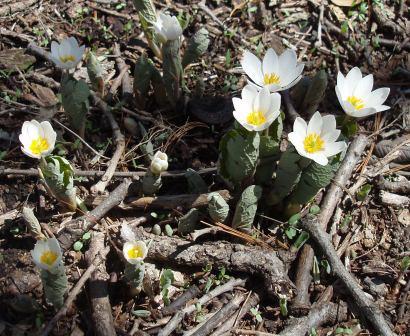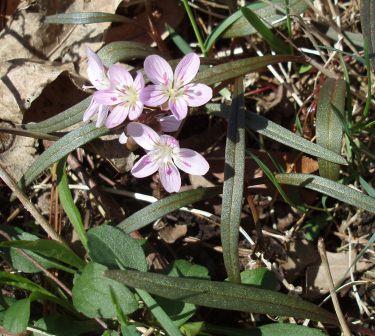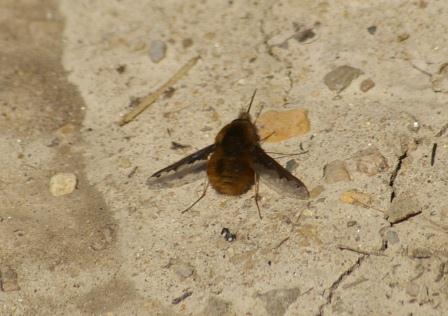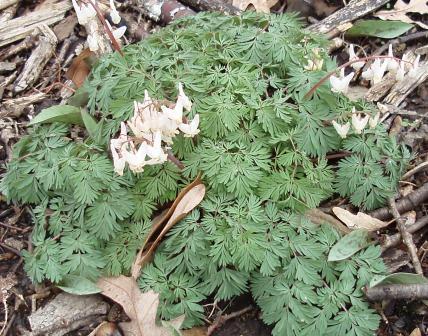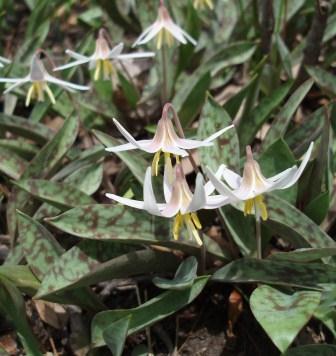by Carl Strang
It’s time to start sharing some of my larger files of notes from personal observations of our vertebrate wildlife. This week’s feature is our local hoofed critter. The preliminary notes, written in the mid-80’s, are more extensive than usual. The dated notes that follow provide many illustrations of the value of tracking in behavior studies.
Deer, Whitetail

Buck in a bed
Deer can be seen in a variety of habitats. Their home range always includes some woodland, brush and meadow or marsh areas. They travel on well used trails, occasionally wandering off them to feed. Commonly they enter meadows to feed at dusk. In winter, they feed on browse. In northern Illinois they hit Rosaceae (blackberries, roses, etc.) early in winter, then eat a variety of woody plants, then by mid-February are eating poison ivy almost exclusively. Cottontails follow the same sequence of foods, but deer-browsed twigs usually are bitten off higher and have a torn edge from the deer’s lack of upper incisors. Through January (though mainly in October and November), bucks attack certain shrubs and saplings along trails, breaking twigs and usually also eating a couple (antler rubs). At Herrick Lake Forest Preserve I noticed that pioneer bur oaks in fields were especially exposed to this abuse.

Shrubs missing bark after being rubbed by a buck’s antlers
Does in spring have fawns which at first remain quietly curled up on ground, freezing when approached. If they do wander, they will call for mother with a sheep-like bleating sound. As their size and strength improve they begin to travel with mother, although on occasion they will drop into a frozen curled position when a threat is detected. Spots can remain into late summer.
Deer flushed close have tail-lifting display, spreading the white hairs underneath (on small fawns the display is disproportionately large). At a distance, when at least partly in cover, they give a high-pitched, whistling snort, often accompanied by a stomping of the feet.
Bony antlers grow slowly through summer, covered with velvety skin. In late fall they dry, the skin comes off. By spring the antlers have been shed.
Tracks usually are 2-toed hoof marks. Leaping deer or those in deep soft substrates also will make 2 smaller dewclaw prints. In deep snow, the tips of the nails often make drag marks. I have seen deer leap over 6-foot fences, and tracks have shown horizontal jumps of more than 12 feet.
In May, deer on Reineman Sanctuary (PA) fed on fiddleheads of hay-scented ferns, but didn’t touch them after they unfolded. Among summer foods were leaves and twigs of greenbrier.

Deer tracks typically show two toes. Here, a deer was walking but accelerating.
27DE86, Memorial Forest near Culver: deer recently browsed sassafras.
10JA87. Herrick Lake Forest Preserve. After last night’s heavy snow, tracks (made this morning, early) only abundant at a large patch of brush in SE corner of preserve, along N edge. All made early this morning except one flushed by a person who was tracking it.
11JA87. Waterfall Glen Forest Preserve. Deer were bedding in snow in same general area, had been there a while before my approach scared them up around 11:30 a.m. They had not cleared a place but just lay down, and the snow barely melted. Beds of the 4 deer were 5-20m apart. Other areas, similar in size and with sides pressed smooth by deer’s body (1 with hairs), had ground bare on the bottom (snow 6 inches deep). In the one with the hairs there were no clear signs of digging, but the others clearly had been dug out.
17JA87, Herrick Lake Forest Preserve. Half an inch of new snow fell the night before. I started tracking in the afternoon, but the tracks were difficult to follow as individual deer and small groups flowed together and apart, anastomosing their trails so that I couldn’t follow an individual for long.
18JA87. McKee Marsh. Better luck. 4 inches of new snow fell overnight, and I was able to follow a single deer for 2 hours, covering about a mile. I was able to stick with him (I believe it was a large buck). I began in the woods near the parking lot, where he followed a winding path, sniffing several shrubs and browsing on a Viburnum (3-lobed leaves and paired red basswood-like buds) and on buckthorn. In one spot where he urinated copiously there were symmetrical shallow hoof marks on either side of his trail, which had the effect of scooping snow into the spot where the urine fell. Then he emerged into open fields E of the woods, wound through a marshy spot, crossed Mack Road, then angled ESE. At one point he suddenly was spooked by a fresh snowmobile track, jumped to the left, then walked across the track and rejoined the trail. Occasionally I had problems when he joined another deer, but by finding every footprint I was able to stay with him until he re-entered the woods and joined 3 other deer. When they split I could not be absolutely sure which he was, but I have about 50% confidence that I followed the right one. He ate more Rhamnus, paused to browse heavily on a young bur oak, wandered up a hill, then joined another galloping deer (and 2-3 others), they all crossed Mack Road onto private property and I could not follow.

Where a buck urinated on his feet, blending tarsal gland secretions with urinary scents
1FE87. Freshly browsed poison ivy, McKee Marsh. Also white ash within the past 2 weeks. Another deer browsed a woodland rosaceous small tree (probably crabapple), 2 inches dbh. Also a basswood. Twice, it defecated shortly after passing under low branches and browsing a few bites. I tracked the deer until I caught up with it in the cattail marsh north of the woods E of the marsh. It had turned to stand in a well hidden spot to watch me. When I got too close it burst from cover, bounded on through the cattails and through the field on the other side. Tracks in field took more of a bound pattern (not so spread front to back) before and after taller weeds, bounding high to clear them.
Later that same day, following another group of deer, I found where one had bedded briefly, at least, in the wet snow.
21FE87. At Greene Valley Forest Preserve. 5 bucks, still with antlers, traveling together as a group. They were moving fast when first seen, traveling through an open field between hedgerows at around noon. They stopped for a while after gaining a second hedgerow, then slowly moved in my direction (I was wearing a navy blue sweatshirt and dark brown pants, and kneeling). They always had one watching me, often all did, but didn’t run away until much later when I stood and walked. Once, a couple sparred with antlers. Mostly 4-6-pointers.
28FE87. At least 3 deer flushed from area thick with saplings and brush under scattered trees, only 150m from busy highway.
23MR87. Waterfall Glen. Deer dead beside creek near intersection of Cass Ave. and 91st Street. Lying in deer-beaver trail, hind feet in water (fracture of left hind tibia partly healed), head end up on bank. Dead at least a week, ribs largely gnawed away, head gone, muscle and internal organs mostly gone except hindquarters. Other tracks of beavers and dog or coyote (probably latter) nearby.
MY87. New Jersey Pine Barrens. Deer browsing blueberries, a little on oaks.
4AU87. Lebanon State Forest, NJ. 4-5 deer flushed from blueberry undergrowth, bounded until out of sight. Then one snorted a couple of times. I could hear them walking in even steps, without the hitching, explosive quality of a towhee. A little sharper and louder than the sound made by the gray fox seen shortly before. That night, as I walked barefoot in the dark, I came within 10 feet of a bedded deer. The deer detected me, and made a terrific racket getting to its feet. By the time it snorted so I knew what it was, I had taken 2 steps back.

Bumps on the head identify this newly spot-free fawn as a male.
3JA88. McDowell Forest Preserve. Following deer tracks, at least 4 days old. Browsed black maple, as well as several scotch pine branch tips (a broken-off branch, about 0.25 inches in diameter where browsed off; twisting and tearing of adjacent needles. Soon thereafter, browsed from a rose bush (prior to all this eating had followed a slightly sinuous path through maple woods, walking steadily). Tracks probably made New Year’s Eve (day before cold front). Feet compacted very wet snow, so probably late afternoon. Stopped to rub antlers on 0.75-inch dbh maple sapling, on its trunk from 1 foot to 2 feet up from ground, bark removed from one side. Soon thereafter it fell in with 2 other deer. Tracks same age, difficult to distinguish, but I believe the one I’m following has a longer stride. They paused to browse buckthorn, maple, rose (mainly the other 2?). Eventually the 3 bedded down beside a multi-stemmed, branchy silver maple in the midst of a field, about 100m from I-88 (in clear view; dark by then). 2 bedded together, third 10 feet from them. They stayed a little while, but still slushy when they left. They headed for the West Branch of the DuPage River, meandered, browsed, another antler rub. Lots of beds in that area. Tracks turn back along stream toward center of preserve. Lots of deer tracks enter and are present in that area by the stream, but none leave. The deer must cross the stream. I backtracked a bit. Buck had been with the others just before I picked up trail, probably was within sight of them throughout.
9JA88. Most of the needles on that pine branch now are browsed away. Deer commonly cross the river just opposite that grove, though routinely bedding among the yews and other ornamental shrubs between there and the stream. Once across, there is a tall fence paralleling the river and about 30 yards on average from it. The deer remain between river bank and fence. A heavily traveled corridor, a bedding area not far from that crossing site. Opposite the zone where I presume they also crossed the river last week, the fence is low enough for them to jump easily, and they either do that, or go under it at a nearby creek (more common), or continue along fence (also common). But soon comes I-88, and it appears to be a complete barrier on that side. A few cross the river there, a few go around the end of the fence. A very few go under I-88, on west side of river. None have crossed in that presumed crossing zone, but the ice probably has been thick enough to support them for only a couple days, and an open lead about 3 feet across runs along the entire east side along that stretch. That might explain why the tracks were running the opposite direction from last week on the stretches-in-common.

When you hold still and allow a deer to approach, it will stare at you and occasionally stomp a foot as though to startle you into moving and revealing yourself.
16JA88. McDowell deer crossed the preserve entrance road just west of the bridge, followed trail steadily between road and river (top of bank). Night before last, not last night. Lost in human and dog tracks, just before widening of area and feeding signs spread out from trail. Well below dam (at least 200m). There signs of much deer activity. Several beds in hill and old-wall area. More feeding and trails (well-used) in even wider area S of there. I flushed a large doe and 2 non-spotted fawns from beds in a pole-tree area a little farther down. They soon circled back around me (to my N). Visible parts: sharp dark horizontal line of back, horizontal white streak of belly cutting through trunks, from side; narrow white outline of tail from back, black nose and eye; brownish cast of fur against gray of trunks (not as distinct).
23JA88. McDowell. Deer recently browsed bur oak sapling. Tracked group of 4-8 deer into NW corner of preserve, brushy area seldom frequented by people, W of beaver pond (dam long, a winding 20-30 yards).
27JA88. Dan Ludwig flew over McDowell and passed on observations of deer: 8 in NW corner, 3 in NE near toll road (both groups west of river, and 6 SE, possibly off preserve.
30JA88. Hartz Lake. Deer trails through woods generally straight, and located to accommodate traveling from one goal to another (goals on either side of woods). Much interdigitation and side-paths abundant around the moist, tall meadows.
29AP88. Pratts Wayne Forest Preserve. Micro pressure releases in one or other toe show where push or pivot was greatest.
1MY88. Warrenville Grove Forest Preserve. Deer ate off tops of several Smilacina racemosa, plus a couple of Alliaria (and other plants, individually removed lower leaves). Not real recently, say 3-8 days ago.
7MY88. Deer tracks, Indian trails of Culver, also ate off tops of a few Smilacina stellata. At Hartz Lake, when one broke a twig loudly, jay responded with “thief” call.
15JL88. Deer heavily eating the Tradescantia at Fulton County museum property, not too long ago. Also eating Seymeria macrophylla.

Antlers nearly grown, but still covered in velvety skin as the bone matures
1AP89. Patch of deer hair on ground in clearing at Hartz Lake. (I also saw some at Winfield Mounds last weekend). Shedding already.
2AP89. Hartz Lake. Deer in groups around clearing (in woods with very little understory) around 9 a.m. A deer snorted. I could just see it through the trees. The nose moved, perhaps a couple inches, but that was the largest motion I could see when it snorted.
13MY89. Hartz Lake, camping. In the dusk, 8 deer came to the prairie area (I was sitting at the opposite edge, by fire). Though basically a doe group, one yearling (small) buck was with them. He was chased a couple times, and a deer struck his back with a forefoot (not a mounting, but a blow). Smaller does still chase after mothers (presumed relationship) to be close to them, when alarmed. I kept still. They saw me, frequently moved heads side to side for parallax.
4JE89. Elsen’s Hill: deer trot pattern showing groups of two prints, 1 foot between prints in a group and 3 feet between groups. Two alternating group types, with front foot of each side ahead of hind foot of other side in that group.
21AU89. Deer tracks, Willowbrook Back 40. Emerged from run, NE corner. Walked down to pond, but stayed above edge (recently arrived, and had drunk from brook?). Nervous. Much starting and stopping, and stomping. Reached a small gulley, then broke into lope, as though the need for the longer step set off a release of nervous energy. 24-inch steps before the lope (toe-tip to toe-tip, measured diagonally). Tendency to splay left front foot and show its dew claws in the lope. While loping, set of 4 tracks 35 inches front to back, groups about 70 inches apart. The tracks were made last night (it had rained the night before last, the tracks made after the rain and after the soil surface had dried). About ten days later: In a hard lope up the hill, the deer showed dewclaws and spread toes on all but the right front. The deer stayed only a couple of weeks. We heard of someone who saw 2 bucks.
2SE89. Tracking deer across screenings trail, McKee Marsh. Stride tended to be slightly longer (23 inches toe tip to toe tip) in tall grass than on path (19-21 inches), except where adjusting stride to clear obstacles. At one point, a hind foot seemed to indicate a turn, falling and pointing to left of the front print, but in fact kept going in the same direction. Response to a disturbance as that foot came down? Implies independence of the 4 feet. Also happened the previous step with that foot.
15SE89. Hartz Lake, edge of open dune. Deer usually pause at edge of clear area before entering it. Shorter strides, and standing.
20SE89. McKee Marsh. A deer, steps 20-20.5 inches on packed screenings trail, became 25-27 inches in tall grass.

Sometimes deer tracks through tall grass are quite clear.
23SE89. Forest Park Nature Center, Peoria, IL. Deer have been browsing Aster shortii, a species of ridgetops, heavily in recent weeks. This has been their main food within the forest in this period, except for acorns.
24NO89. Hartz Lake. 2 deer beds, SE corner (behind cemetery) in woods. Windy day, saw 2 deer crossing road mid-afternoon, and as I studied tracks on the open dune a doe with a broken or injured right front leg limped past.
13DE89. Hartz Lake. Deer heavily using main north-south trail past couple of days (since snowfall).
16DE89. McDowell Forest Preserve. Patterns of deer activity in west part of preserve much the same as last winter. The only difference is a possible shift from the old home site to the center of the adjacent field in the north part of the preserve. If anything, there is even more concentration of activity to the north end of the preserve than before.
4FE90. Recently shed antler near mouth of Sawmill Creek, Waterfall Glen Forest Preserve.
Late MY90. Hartz Lake. A deer appeared to stomp and snort as a gambit to make me move. Odor and sound spooked them more than small movements.
9JE90. Winfield Mounds. Heavy feeding by deer on goldenrods, past couple of weeks.

Wet forest litter from a recent rain foiled this fawn’s camouflage. Fawn spots form individualized patterns that permit recognition of individuals as long as they last.
30JE90. West DuPage Woods. Fawn moving about and exploring on its own. Still small, but strong. I held still, it slowly moved toward me, sniffing and occasionally stamping like an adult. When mother appeared, and bolted, it ran, too. Tail flag.
13JL90. McKee Marsh. As I was running through the forest, I saw a fawn, approaching half adult size, on the trail ahead. I slowed and quieted my steps. It bolted when I was 10 yards away, and its mother and its sibling, who were close by, bolted as well. Unless the mother gave an audible signal I missed (unlikely, though I was so focused on the fawn that I didn’t see her), she was waiting for the fawn to make the move. If so, she was teaching it to run away from people and to react on its own without depending on her signal.
2JE91. First fawn tracks of the year, Pratts Wayne Woods Forest Preserve.

Doe and fawn. By November, the fawns’ spots are gone.
21DE91. Hidden Lake Forest Preserve. Followed last night’s tracks of a very large deer, sex uncertain but more likely male. Traveled relatively straight lines through open field, but began highly convoluted turnings in a brushier area as it began feeding. Principal (only?) food Geum laciniatum basal leaves, nosed rather than pawed snow to reach them. Ate many. Went out of its way to examine a coyote or dog bed. Bedded, itself, several hours. Note: outward tracks from bed looked older than inward ones. Snow apparently less compactable, or more easily self-kicked back into track, with less smoothly compacted bottom of track and less crisp edges. Wandered and fed more after leaving bed. Defecated several times.
17FE92. Elsen’s Hill (W. DuPage Woods Forest Preserve.). I kept mainly to deer trails, saw 2 deer in a brushy area and, later, in a forest, saw 2 getting up from their beds. I stood still for a while, there, listening, and soon caught movement. Three deer slowly moved into view. Almost certainly the ones I had spooked, a doe and 2 fawns. I kept very still and they approached, the doe doing the foot-stomping test. Sometimes it appears to be largely a nervous expression, others it is very deliberate and calculated, the deer staring hard and keeping its head still while doing so. The fawns kept back. Several times she gradually worked to within 20 yards, then abruptly turned and ran, tail flagging, the fawns doing so as well. On one of these occasions she snorted several times. But I kept still, she didn’t go far, and repeated the process. The closest she ever came was 40 feet. I was wearing the green and black wool coat, standing clear of trees, with a medium density of 2-4-inch dbh trees and a few large ones in that area. The deer finally left for good at the sound of human voices on a trail not too far away, but the deer walked away rather than ran. During all of this there were occasional crows and squirrels seeing me and vocalizing. The deer attended the squirrels, but not the crows, starting at the squirrel’s bark and becoming more wary of me.
3OC93. Rock Island Park, Wisconsin. 2 bucks facing one another, heads lowered near to ground, maneuvering antlers. Like arm-wrestlers seeking best grip.
Early in the 90’s I had a season of deer hunting. During a several-day cold rainy period I sat for hours without seeing any deer. On drier days they were active.
Deer visited several times during the 90’s at Willowbrook. Usually they stayed 2 weeks at most, but during the summer of 1997 a couple of them stayed from May into August.
JE99, Kansas, Konza Prairie. A deer snorted and ran as I approached, holding head and nose above horizontal a bit while snorting.
15MY06. Fullersburg. A deer eating Virginia creeper leaves from a ground vine.

During the 3 years my office was at Fullersburg Woods Forest Preserve, I mapped the winter movements of the preserve’s deer. In the winter of 2006-7 there were 4 groups which followed consistent daily routes as shown.
28AP08. New antlers beginning to grow on bucks (similar stage photographed 3 May last year).

New antlers just starting to grow
15SE10. Meacham Grove. While doing herbivory data collecting I saw 3 antlerless deer. One, a fawn that had become spotless, made a persistent effort to nurse from its mother for a minute or so until she pushed it away. The third I believe was another adult doe.




























